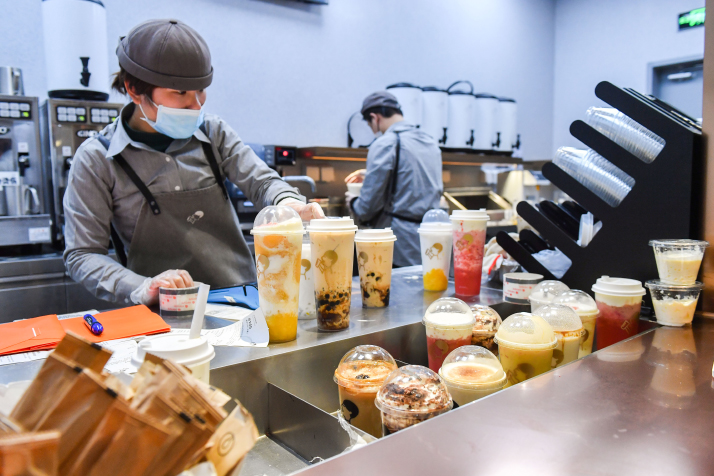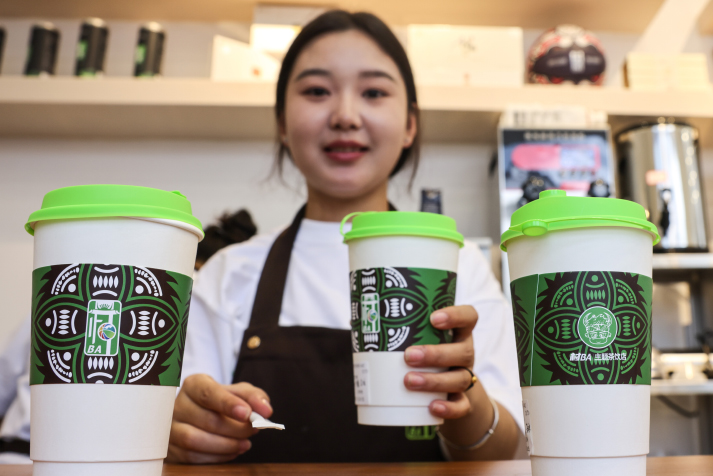
One of the most significant changes this "witness" has observed in recent years is the trend toward healthier products.
"A few years ago, the streets near my college were lined with stores offering cheap tea beverages—about 8 yuan ($1.1) a cup, or even cheaper," Zhang told Beijing Review. "Back then, customers, including myself, were already aware these beverages contained quite a few unhealthy ingredients—such as tea powder and non-dairy creamer, typically made from a combination of water, sugar, vegetable oil and additives such as stabilizers and emulsifiers. But these stores have been disappearing in recent years, while novel brands have begun to dominate the market."
Zhang's observations seem to align with current trends.
On January 5, state broadcaster China Central Television's website reported on a survey conducted by China Consumer Journal, revealing that over 70 percent of surveyed customers are increasingly critical of the quality of the ingredients used in tea beverages. For instance, 54.65 percent expressed an aversion to milk tea made with non-dairy creamer instead of real milk. A report released by the China Food and Health Seven Star Alliance, a nonprofit industry organization, also shows that 80.87 percent of Gen Zs prioritize nutrition and health when choosing food and beverage products.
Then, on January 24, the hashtag "tea beverage brands are starting to disappear" surged into the top 10 trending topics on Weibo, China's equivalent of X. The tag referred to the gradual fading away of tea brands using non-dairy powder and artificial flavors.
Healthy pursuits
Measured by materials and ingredients, China's tea beverage industry can be classified into three stages.
The first generation, which started around the early 2000s, and is referred to as the "powder era," was dominated by non-dairy creamer and tea powder, both known for being affordable, primarily available as pre-packaged products in supermarkets.
The second generation, known as the "street era," saw the proliferation of tea beverage shops in the 2010s, where the use of fresh milk, processed tea packs and fruit prevailed.
Today's third generation, known as the "new-style tea era," is characterized by its use of authentic or traditional loose tea leaves, high-quality milk and fresh fruit.
According to Zhang, young people today are increasingly concerned about their health and physique, and are therefore willing to spend more on healthier products.
"I remember how my mother used to send me articles highlighting the unhealthy nature of tea beverages, along with videos of staff pouring artificial sweetener, tapioca pearls and low-quality tea into cups," Zhang shared. She added that she and many of her friends have shifted toward pricier but healthier alternatives.
A cup of Da Hong Pao tea, originating from the Wuyi Mountain region in the southeastern province of Fujian and therefore also known as Wuyi rock tea, mixed with low-fat pasteurized milk and topped off with slices of fresh seasonal fruit and a sprinkling of Oreo crumbs, is one such alternative—and sells for 30 to 40 yuan ($4.2-5.5).
Belonging to the oolong tea category, a traditional Chinese tea that possesses a range of health benefits, Da Hong Pao is one of the top 10 most famous teas in China. Renowned for its rich health benefits and enjoyable flavor, numerous prestigious tea beverage brands have started to incorporate Da Hong Pao into their products, often highlighting its benefits with tags like "low-calorie," "endorsed by esteemed tea masters" and "providing essential nourishment."
Several pioneering tea brands and beverage chains have made substantial efforts to create products by including ingredients known for their health-promoting properties. To reassure consumers, these brands even invite third-party agencies to conduct "health tests" on their products.
Zhang expressed her excitement about the forthcoming strategies brands will implement to attract and engage health-conscious consumers. "I hope that tea beverages continue to evolve toward even greater levels of healthiness. For customers, there's no such thing as being 'too healthy'," she said.

Sipping smart
According to the Report on the Development Status and Consumption Trend of China's New Tea Industry released by iiMedia Research, a market consultancy focusing on the emerging economy field, the market size of China's new-style tea industry had reached 279.59 billion yuan ($38.78 billion) in 2021. Given the country's vast mobile Internet penetration rate and the rapid expansion of digital technology, coupled with young people's preference for healthier options, the market is projected to reach 374.93 billion yuan ($52 billion) by 2025.
Tian Liyuan, head of the research department at Beijing's Zhongguancun Xinzhiyuan Health Management Institute, emphasized the need for brands to adapt to this evolving market trend by enhancing their products' health profiles.
"More and more consumers are embracing a healthier lifestyle, propelling a shift in dietary habits. Brands in the new-style tea industry should focus on creating nourishing and low-calorie products to align with the changing preferences of consumers," Tian said in an interview with Chinanews.com.
A manager of a tea beverage store in Beijing surnamed Wang told Beijing Review how many related brands are racking their brain to come up with new, healthy products. This intense market competition has presented a challenge for Wang's staff to keep up with the constantly evolving trends and demands.
"New products mean new ingredients, new methods [for making the beverage, storing materials and even updating machines], and new training," Wang clarified. "In the past two years, we have introduced new products almost every month, and during peak times, such as August, we get new products every week. It's exhausting to keep pace with the constantly changing lists."
Wang also explained how this "healthy revolution" is putting his staff management skills to the test.
"For many people, working at a tea shop is a temporary gig. They're usually here for four to six months and then quit. During summer and winter holidays, when college students are free, they come here for a part-time job and then go back to school. The frequent personnel changes require me to constantly train new employees," Wang said, adding that it's even harder for temps to stay in step with monthly new lists.
From Wang's perspective, when research and development departments are looking into new products, companies should come up with better ways to cope with the impacts on supply chains, logistics and retail staff training.
"The fast-growing 'healthy' trend is positive, but it poses great challenges to the industry, and these problems need to be fixed," Wang said.
Copyedited by Elsbeth van Paridon
Comments to zhangyage@cicgamericas.com